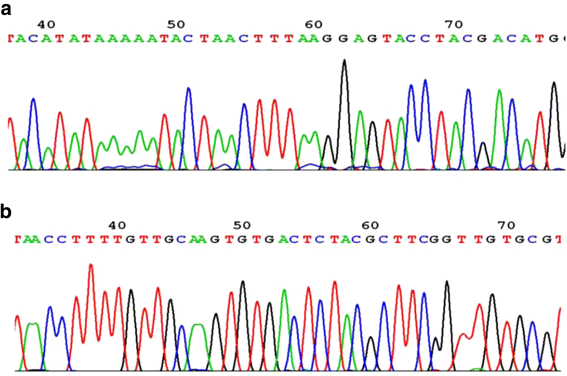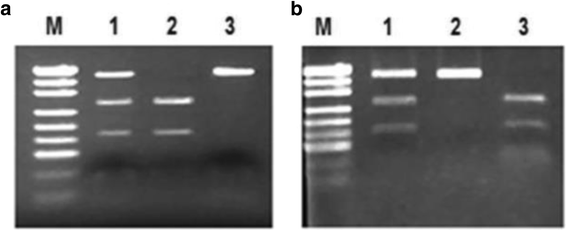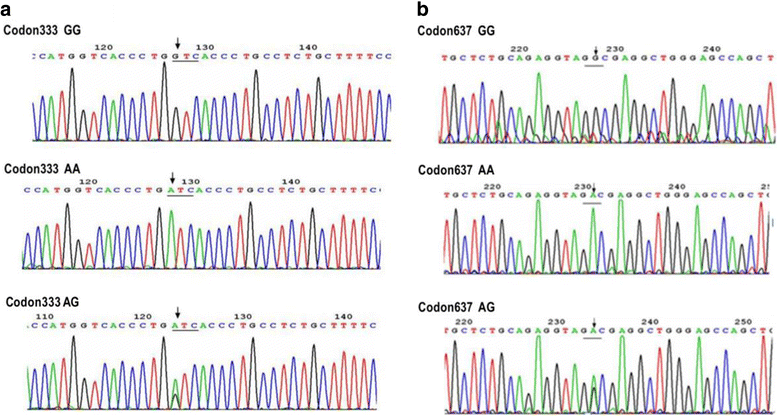Heterozygote of TAP1 Codon637 decreases susceptibility to HPV infection but increases susceptibility to esophageal cancer among the Kazakh populations
- PMID: 26205887
- PMCID: PMC4514451
- DOI: 10.1186/s13046-015-0185-y
Heterozygote of TAP1 Codon637 decreases susceptibility to HPV infection but increases susceptibility to esophageal cancer among the Kazakh populations
Abstract
Background: The role of human papillomavirus (HPV) may be involved in the development of esophageal cancer (EC) and the polymorphic immune response gene transporter associated with antigen processing (TAP) may be involved in HPV persistence and subsequent cancer carcinogenesis. The current study aims to provide association evidence for HPV with EC, to investigate TAP1 polymorphisms in EC and assess its association with HPV statuses and EC in Kazakhs.
Methods: The HPV genotypes in 361 patients with EC and 66 controls selected from Kazakh population were evaluated using PCR. Polymerase chain reaction-restriction fragment length polymorphism (PCR-RFLP) was performed to detect two SNPs of TAP1 in 150 cases comprised of 75 HPV(+) and 75 HPV(-) patients and 283 pure ethnic population of Kazakh and evaluate their associations with susceptibility to EC. A case-to-case comparison based on the genotyping results was conducted to address the function of TAP1 variants in the involvement of HPV.
Results: The presence of four HPV genotypes in EC tissues - including HPV 16, 18, 31, 45 - was significantly higher at 64.6 % than those in controls at 18.2 % (P < 0.001). Such presence was strongly associated with increased risk of EC (OR 8.196; 95 % CI 4.280-15.964). The infection of HPV16, and multi-infection of 16 and 18 significantly increase the risk for developing EC (OR 4.616, 95 % CI 2.099-10.151; and OR 6.029, 95 % CI 1.395-26.057 respectively). Heterozygote of TAP1 D637G had a significantly higher risk for developing EC (OR 1.626; 95 % CI 1.080-2.449). The odds ratio for HPV infection was significantly lower among carriers of TAP1 D637G polymorphism (OR 0.281; 95 % CI 0.144-0.551).
Conclusions: HPV infection exhibits a strong positive association with the risk of EC in Kazakhs. Heterozygote of TAP1 D637G decreases susceptibility to HPV infection in patients with EC but increases susceptibility to EC among the Kazakh populations.
Figures




Similar articles
-
Heterozygote of PLCE1 rs2274223 increases susceptibility to human papillomavirus infection in patients with esophageal carcinoma among the Kazakh populations.J Med Virol. 2014 Apr;86(4):608-17. doi: 10.1002/jmv.23775. Epub 2013 Oct 11. J Med Virol. 2014. PMID: 24127316
-
Genetic variability in LMP2 and LMP7 is associated with the risk of esophageal squamous cell carcinoma in the Kazakh population but is not associated with HPV infection.PLoS One. 2017 Oct 26;12(10):e0186319. doi: 10.1371/journal.pone.0186319. eCollection 2017. PLoS One. 2017. PMID: 29073155 Free PMC article.
-
Multiple polymorphisms within the PLCE1 are associated with esophageal cancer via promoting the gene expression in a Chinese Kazakh population.Gene. 2013 Nov 10;530(2):315-22. doi: 10.1016/j.gene.2013.08.057. Epub 2013 Aug 24. Gene. 2013. PMID: 23981775
-
[Study on the ingestion of folate and polymorphism of MTHFR C677T with esophageal cancer in Xinjiang Kazakh].Zhonghua Liu Xing Bing Xue Za Zhi. 2008 Jan;29(1):30-3. Zhonghua Liu Xing Bing Xue Za Zhi. 2008. PMID: 18785474 Chinese.
-
Microbiome factors in HPV-driven carcinogenesis and cancers.PLoS Pathog. 2020 Jun 4;16(6):e1008524. doi: 10.1371/journal.ppat.1008524. eCollection 2020 Jun. PLoS Pathog. 2020. PMID: 32497113 Free PMC article. Review. No abstract available.
Cited by
-
ABC Transporters and Their Role in the Neoadjuvant Treatment of Esophageal Cancer.Int J Mol Sci. 2018 Mar 15;19(3):868. doi: 10.3390/ijms19030868. Int J Mol Sci. 2018. PMID: 29543757 Free PMC article. Review.
-
p53 expression but not p16(INK4A) correlates with human papillomavirus-associated esophageal squamous cell carcinoma in Kazakh population.Infect Agent Cancer. 2016 Apr 13;11:19. doi: 10.1186/s13027-016-0065-x. eCollection 2016. Infect Agent Cancer. 2016. PMID: 27076841 Free PMC article.
-
Transporter Associated With Antigen Processing (TAP) 1 Gene Polymorphisms and Risks of Urothelial Cell Carcinoma Among the Japanese Population.Cureus. 2024 Jan 15;16(1):e52310. doi: 10.7759/cureus.52310. eCollection 2024 Jan. Cureus. 2024. PMID: 38357083 Free PMC article.
-
HBV/HIV co-infection and APOBEC3G polymorphisms in a population from Burkina Faso.BMC Infect Dis. 2016 Jul 22;16:336. doi: 10.1186/s12879-016-1672-2. BMC Infect Dis. 2016. PMID: 27449138 Free PMC article.
-
Nucleic acid aptamer controls mycoplasma infection for inhibiting the malignancy of esophageal squamous cell carcinoma.Mol Ther. 2022 Jun 1;30(6):2224-2241. doi: 10.1016/j.ymthe.2022.02.018. Epub 2022 Feb 18. Mol Ther. 2022. PMID: 35189346 Free PMC article.
References
-
- Morita M, Kumashiro R, Kubo N, Nakashima Y, Yoshida R, Yoshinaga K, Saeki H, Emi Y, Kakeji Y, Sakaguchi Y, et al. Alcohol drinking, cigarette smoking, and the development of squamous cell carcinoma of the esophagus: epidemiology, clinical findings, and prevention. Int J Clin Oncol. 2010;15:126–134. doi: 10.1007/s10147-010-0056-7. - DOI - PubMed
Publication types
MeSH terms
LinkOut - more resources
Full Text Sources
Other Literature Sources
Medical
Research Materials
Miscellaneous

